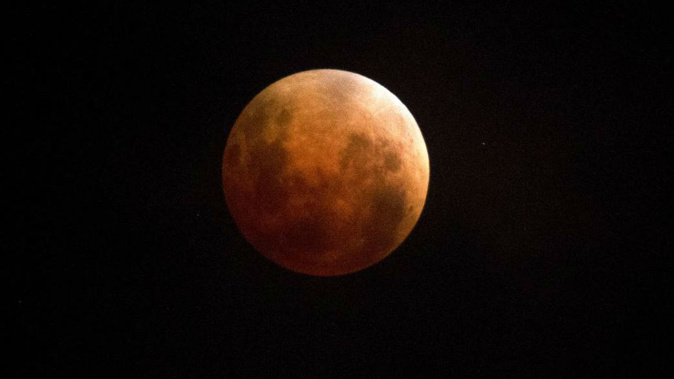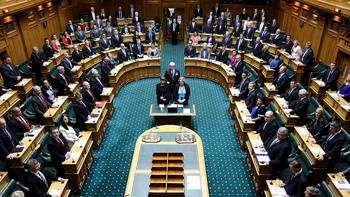
The heavens are treating star-gazers to one stunner of a variety show.
This co-incidental celestial festival boasts an eclipsed "blood moon" sharing a sky with the Sun this morning Mars coming at its closest point for the next 17 years; and several other planets showing up more brightly overhead.
BLOOD MOON FOR BREAKFAST
Yesterday's Mars event would be followed on this morning by another rare happening - an eclipsed moon that could be visible on one horizon while the Sun rose on the other.
This spectacle, called a selenelion, was due to unfold a few minutes after 8am, and could be best viewed in southern areas, provided their skies were clear.
Being able to see the Sun and a lunar eclipse at once might be thought impossible, given these events typically happened when the Sun, the Earth and the moon were all in a straight line.
But the bending of the rays of light caused by our atmosphere made it feasible to see the selenelion, so long as we were in the right place.
Because the total lunar eclipse had be ongoing at the time of moonset and sunrise, there were few vantage points on our planet to experience it - but New Zealand was fortunately one of them.
/arc-anglerfish-syd-prod-nzme.s3.amazonaws.com/public/XIH7X37XHBE3BDMVUE64Y2FQCA.jpg) The view of the eclipse from New Market. Photo / Lynn Clayton
The view of the eclipse from New Market. Photo / Lynn Clayton
In our case, Otago and Southland stood to get the best glimpse, although, even from Auckland, the eclipse would still be partial as the moon disappeared below the horizon.
For those in areas from Whanganui to Wellington, there would be just a slim chance of glimpsing the totally-eclipsed moon as the Sun peeked above the horizon.
In Invercargill, there would be five minutes between sunrise at 8.12am and moonset shortly after, with the moon entirely within Earth's shadow.
In Dunedin, the interval would be reduced to four minutes; in Christchurch, three minutes.
During the total eclipse - due to begin at 7.30am - the moon would appear much fainter than it usually appeared, and coloured between dark brown and blood red.
The colouration of this so-called "blood moon" - an occurrence shrouded in ancient superstition - was due to some sunlight leaking through Earth's atmosphere and reaching the moon.
Red light had a better chance of doing so for the same reason the sky was blue - shorter wave-lengths were scattered more efficiently by the molecules in our atmosphere.
"Although there is a lunar eclipse visible from New Zealand every couple of years, on average, being located in the right place to see a celestial peculiarity like a selenelion is much less frequent, and very few people have witnessed one," said Dr Duncan Steel, of Otago's Centre for Space Science Technology.
The lunar eclipse from Gisborne, New Zealand. :) pic from using my phone and telescope. #lunareclipse #lunareclipse2018 #NewZealand #astronomy pic.twitter.com/aommNypM42
— Becca 🇳🇿 (@Timaeus_NZ) July 27, 2018
MARS MARVEL
Yesterday marked what astronomers refer to as the "opposition" of Mars - something that took place around every two years, when Earth lined up directly between Mars and the Sun.
This phenomenon could be explained by the elliptical or oval-shaped orbits that Earth and Mars followed around the Sun.
The fact our planet was closer than Mars, meant Earth sped along its orbit faster, taking two trips around the Sun in the same time it took for Mars to make just a single circuit.
Eventually, the two planets aligned - but sometimes the match-up proved much more special.
When Mars happened to be closest to the Sun in its orbit, which occurred within a few weeks of opposition, a "perihelic opposition" resulted, and Mars appeared even bigger and brighter.
Such events only happened around every 17 years – and some brought us closer than others.
The 2003 opposition was especially significant, being the closest opposition in the past 60,000 years.
This year's conditions weren't quite as extraordinary, but Mars would still only appear four per cent smaller than that spectacle.
It was likely the next time the two planets would be at a perihelic opposition, in 2035, humans would have walked upon the surface of Mars.
Mars wouldn't be at its closest to Earth until about 3.50pm on Tuesday.
At that point, we'd be an estimated 57.6 million km away, which was much closer than our average distance apart of 225 million km.
And even at this point last month, Mars was still 70.8 million km from us.
Interestingly, the occurrence came as scientists have discovered the first large body of liquid water on the red planet.
A PLANETARY BANQUET
People also might have noticed five planets - Mercury, Venus, Jupiter, Saturn and Mars - all together in the evening sky lately.
"It's a co-incidence, basically," astronomer Dr Grant Christie said.
"First, if we consider Saturn and Jupiter - Saturn goes around the sun every 30 years, while Jupiter goes around it every 12 years, so for a large chunk of time they're on opposite sides of the sky, and never seen at the same time.
"It just so happens that at the moment Jupiter is passing Saturn, so they are both closer together in the sky at the present time."
Added to that were the unusual cameos of Mercury and Venus - planets that were more typically perched either just to the east or west of the Sun.
"Most of the time, they're obscured by the brightness, so again, it's relatively unusual to have them both in the western sky where people can see them both."
Mercury was now not as visible as it had been, but Venus could still be viewed more clearly than normal.
"If this was happening in the pre-dawn sky, we wouldn't be paying much attention, but when they're all there in the evening sky, people are more likely to take notice."
Christie said the combination of all these events was interesting, but nonetheless all predictable under the laws of astronomy.
"It's pure clockwork."
Take your Radio, Podcasts and Music with you









